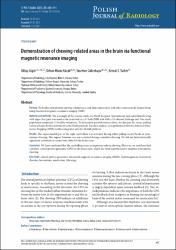Demonstration of chewing-related areas in the brain via functional magnetic resonance imaging
Özet
Purpose: To localize and identify chewing-related areas and their connections with other centres in the human brain
using functional magnetic resonance imaging (fMRI).
Material and methods: The paradigm of the present study was block designed. Spontaneous and controlled chewing
with sugar-free gum was used as the main task in a 3-Tesla fMRI unit with a 32-channel birdcage coil. Our study
population comprised 32 healthy volunteers. To determine possible intersections, we also put the rosary pulling
(silent tell one’s beads) movement in the fMRI protocol. The data analyses were performed with the Statistical Parametric Mapping (SPM) toolbox integrated into the Matlab platform.
Results: The superomedial part of the right cerebellum was activated during either pulling rosary beads or spontaneous chewing. This region, however, was not activated during controlled chewing. We did not find statistically
significant activation or connection related to the brain stem.
Conclusion: We have confirmed that the cerebellum plays an important role in chewing. However, we could not find
a definite central pattern generator (CPG) in the brain stem, which has been hypothesized to underlie spontaneous
chewing.
Cilt
88Bağlantı
https://hdl.handle.net/11363/4500Koleksiyonlar
Aşağıdaki lisans dosyası bu öğe ile ilişkilidir:


















